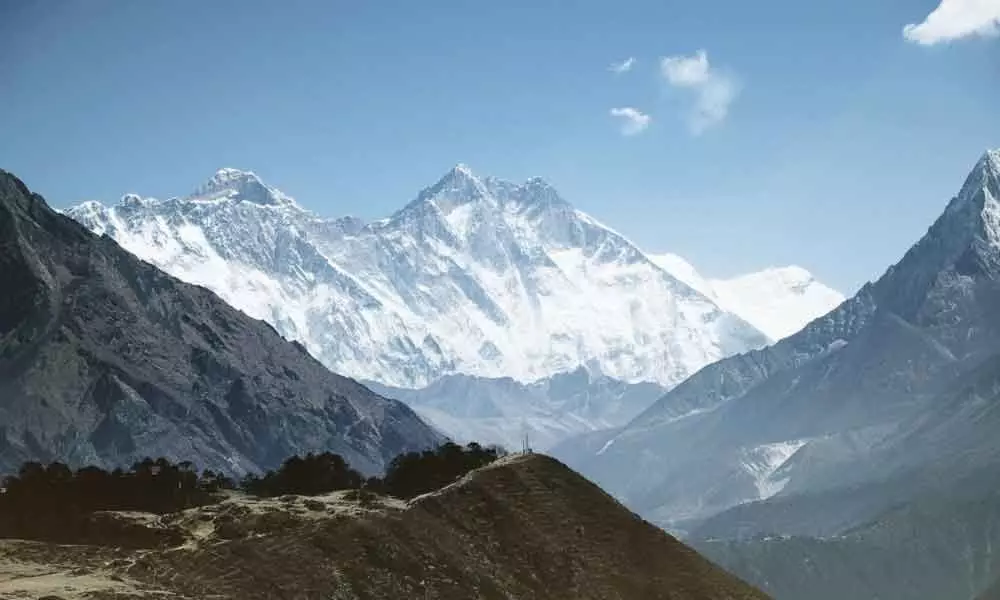Live
- BGT: Rohit, KL Rahul suffer injury scares ahead of Boxing Day Test
- PM Modi Visits Indian Labour Camp And Engages With Diaspora In Kuwait
- South Korea: Main opposition urges acting president to sign special counsel bills or face consequences
- Central PSUs record 47 per cent jump in net profit for 2023-24, market cap doubles
- Man In Madhya Pradesh Dies By Suicide, Leaves Video Alleging Harassment
- AAP Likely To Replace Shoaib Iqbal With Son Aaley Muhammad Iqbal For Matia Mahal Seat
- Multi-Storey Building Collapse In Mohali Triggers Massive Rescue Operation
- Anti-Corruption Officers Assaulted By Revenue Clerks In Uttar Pradesh
- Earthquake tremors felt again in Prakasam district
- G Trisha, spinners star as India win inaugural U19 Women’s Asia Cup title
Just In
Humans altered Himalayan glacier long before people arrived: Study


Human activity may have contaminated one of the highest peaks in the central Himalayas hundreds of years before a person ever set foot there, according to a study.
Human activity may have contaminated one of the highest peaks in the central Himalayas hundreds of years before a person ever set foot there, according to a study.
The study, published in the journal PNAS, indicates that the byproducts of burning coal in Europe in the late 18th century made their way to the Dasuopu glacier, about 10,300 kilometres from London, the birthplace of the Industrial Revolution. "The Industrial Revolution was a revolution in the use of energy," said Paolo Gabrielli from The Ohio State University in the US.
"And so the use of coal combustion also started to cause emissions that we think were transported by winds up to the Himalayas," Gabrielli said. The research team was part of a larger international team that travelled to Dasuopu in 1997 to drill ice cores from the glacier.
Dasuopu -- at 7,200 metres above sea level -- is the highest-altitude site in the world where scientists have obtained a climate record from an ice core, the researchers said. Dasuopu is located on Shishapangma, one of the world's 14 tallest mountains, which are all located in the Himalayas, they said. The team analysed one core taken from Dasuopu in 1997 for 23 trace metals. The ice cores operate as a sort of timeline, and show new ice forming in layers on the glacier over time. It is possible for researchers to tell almost the precise year a layer of the glacier formed because of environmental clues like snowfall or other known natural or human-made disasters.
The researchers determined the ice the researchers evaluated formed between 1499 and 1992. They found higher-than-natural levels of a number of toxic metals, including cadmium, chromium, nickel and zinc, in the ice starting at around 1780 -- the very start of the Industrial Revolution in the UK. Those metals are all byproducts of burning coal, a key part of industry at the end of the 18th century and throughout the 19th and 20th centuries, according to the researchers.
They found that those metals were likely transported by winter winds, which travel around the globe from west to east. The researchers also believe it is possible that some of the metals, most notably zinc, came from large-scale forest fires, including those used in the 1800s and 1900s to clear trees to make way for farms.
"What happens is at that time, in addition to the Industrial Revolution, the human population exploded and expanded," Gabrielli said. "And so there was a greater need for agricultural fields - and, typically, the way they got new fields was to burn forests," he said.
Gabrielli said it is difficult to tell whether the glacial contamination comes from human-made or natural forest fires. There are few high-altitude records of large-scale fires from around the world, making that contamination more difficult to track, they said.
The analysis found contamination in the ice core records was most intense from about 1810 to 1880. Gabrielli said that is likely because winters were wetter than normal in Dasuopu during that time period, meaning more ice and snow formed.
That ice and snow, he said, would have been contaminated by fly ash from the burning of coal or trees that made its way into the westerly winds. Greater quantities of contaminated ice and snow means more contamination on the glacier, the researchers said. The contamination appeared long before humans scaled the mountains around Dasuopu, the researchers noted.
The first mountain climbers reached the summit of Mount Everest, at 29,029 feet the world's highest peak above sea level, in 1953. Shishapangma was first climbed in 1964. The Dasuopo glacier drilling site is about 2,700 feet below the summit, according to the researchers.

© 2024 Hyderabad Media House Limited/The Hans India. All rights reserved. Powered by hocalwire.com






